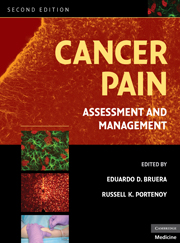Book contents
- Frontmatter
- Contents
- Contributors
- Preface
- SECTION I MECHANISMS AND EPIDEMIOLOGY
- SECTION II EPIDEMIOLOGY AND SYNDROMES
- SECTION III ASSESSMENT
- SECTION IV PHARMACOLOGICAL TREATMENT
- SECTION V OTHER INTERVENTIONAL STRATEGIES
- SECTION VI REHABILITATION AND PSYCHOLOGICAL INTERVENTIONS
- SECTION VII THE ROLE OF ANTINEOPLASTIC THERAPIES IN PAIN CONTROL
- 20 Palliative radiotherapy
- 21 Palliative systemic antineoplastic therapy
- SECTION VIII PAIN IN SPECIAL POPULATIONS
- SECTION IX DIFFICULT PAIN PROBLEMS
- SECTION X SYSTEMS OF CARE
- Index
- Plate section
- References
20 - Palliative radiotherapy
from SECTION VII - THE ROLE OF ANTINEOPLASTIC THERAPIES IN PAIN CONTROL
Published online by Cambridge University Press: 06 July 2010
- Frontmatter
- Contents
- Contributors
- Preface
- SECTION I MECHANISMS AND EPIDEMIOLOGY
- SECTION II EPIDEMIOLOGY AND SYNDROMES
- SECTION III ASSESSMENT
- SECTION IV PHARMACOLOGICAL TREATMENT
- SECTION V OTHER INTERVENTIONAL STRATEGIES
- SECTION VI REHABILITATION AND PSYCHOLOGICAL INTERVENTIONS
- SECTION VII THE ROLE OF ANTINEOPLASTIC THERAPIES IN PAIN CONTROL
- 20 Palliative radiotherapy
- 21 Palliative systemic antineoplastic therapy
- SECTION VIII PAIN IN SPECIAL POPULATIONS
- SECTION IX DIFFICULT PAIN PROBLEMS
- SECTION X SYSTEMS OF CARE
- Index
- Plate section
- References
Summary
Introduction
External beam radiotherapy (EBRT) meets the criteria for a good palliative intervention for control of cancer pain, and in this chapter, some guiding principles for decision making in treatment planning are described. New developments in the prevention of adverse effects secondary to radiotherapy (RT) are discussed. The effectiveness of RT for nociceptive, neuropathic, and visceral pain are demonstrated using the settings of bone and brain metastases as the main clinical examples, and RT's role in the treatment of complications of bone metastases are outlined. The integration of palliative RT with other modalities, issues surrounding reirradiation, and current controversies also are highlighted.
Radiotherapy
When ionizing radiation travels through a living cell, it can damage the reproductive material in the cell either directly or indirectly. Direct DNA damage includes base deletions and single- and double-strand breaks. Indirect damage occurs when radiation ionizes water molecules, resulting in free radicals, which in turn damage DNA. Repair of DNA damage is possible in both normal cells and cancer cells, but cancer cells have less capacity to do so, creating a therapeutic ratio that can be exploited. This is part of the rationale behind fractionation, or dividing the total dose of radiation into a number of smaller doses (fractions) delivered over time: This allows normal tissues to repair damage that cancer cells cannot. Typically, patients are treated once per day, Monday through Friday, a schedule that has evolved empirically to balance normal tissue repair with tumor cell kill, although there are clinical scenarios in which more than one treatment is given per day or treatment is administered on weekends.
- Type
- Chapter
- Information
- Cancer PainAssessment and Management, pp. 379 - 398Publisher: Cambridge University PressPrint publication year: 2009



